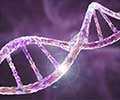Researchers have uncovered important information about how water reacts with the guanine of the ionized DNA, a critical step in DNA mutation that has eluded researchers for decades
Researchers have uncovered important information about how water reacts with the guanine of the ionized DNA, a critical step in DNA mutation that has eluded researchers for decades. In the study that appears in the August edition of the Journal of the American Chemical Society, scientists at the Georgia Institute of Technology have reported uncovering an important step in DNA mutation underlying many forms of cancer that could be critical to the development of strategies for cancer prevention and treatment.
The process that gives rise to mutations in DNA, or mutagenesis, is a complex one involving a series of chemical reactions, which are not completely understood. A free radical, a stable neutral atom or a chemical group containing at least one unpaired electron, can scavenge an electron from DNA in a process known as oxidation, creating a hole in place of the scavenged electron. Such oxidation events can be caused by natural processes occurring in the body, or by ionizing radiation. It's well known that the ionization hole can travel long distances of up to 20 nanometers along the base pairs that form the rungs of the DNA ladder (discussed by Landman, Schuster and their collaborators in a 2001 Science article, volume 294, page 567). It is also well known that the hole tends to settle longer at spots in the DNA where two guanines (G) are located next to each other.It's the next step that has eluded DNA researchers for decades - somehow the hole in the ionized DNA reacts with water. This critical step is the first in a series that brings about a change in the DNA molecule – one that evades the body's proof reading mechanism and leaves the altered DNA coding for the wrong proteins. When the wrong proteins are produced, it can lead through a complicated chain of events to an abnormally high rate of cell division – the result is cancer.
"We set out to explore the elementary processes that lead to mutagenesis and eventually cancer," said Uzi Landman, director of the Center for Computational Materials Science and Regents' professor and Callaway chair of physics at Georgia Tech.
"Until now, the mechanism by which water reacts with the guanine of the ionized DNA remained a puzzle. Through our first-principles, computer-based quantum mechanical theoretical modeling, coupled with theory-driven laboratory experiments, we have gained important insights into a critical step in a reaction that can have far reaching health consequences," he said.
Once the hole is settled on the two guanine bases, water molecules react with one of the bases at a location called the 8-th carbon site (C8). This reaction converts it into 8-oxo-7, 8-dihyrdroguanine (8-Oxo-G). But, this reaction requires more energy than seems to be available because, formally, it requires that a water molecule (H2O) split apart into a proton (H+) and a hydroxyl anion (OH-). This large energy requirement has puzzled scientists for a long time. Now the research team, led by Landman and Gary Schuster, provost-designate of Georgia Tech, professor of Chemistry and dean of the College of Sciences, has uncovered how the reaction occurs.
Here's what they found: A sodium counter-ion (Na+) diffusing in the hydration environment of the DNA molecule wanders into the major groove of the DNA double helical ladder. When the Na+ comes close to the hole created by the missing electron, its positive charge promotes the C8 carbon atom of the guanine to bond with a water molecule. In a concerted motion, the oxygen atom of the water molecule with one of its hydrogen atoms attaches to the C8 carbon atom. At the same time, the other proton of the water molecule connects the oxygen atom to that of a neighboring water molecule. This hydrogen bond elongates, leading to the formation of a transition state complex involving the two neighboring water molecules. The complex breaks up, transferring one of its protons (a positively charged hydrogen atom) to the neighboring water molecule, making a hydronium ion H3O+. This leaves the guanine neutral, with the rest of the first water molecule attached to it and prepares it for the rest of the already-known steps to making 8-Oxo-G.
Advertisement
The phosphate is crucial to the reaction because it acts as a sink that holds one of the reaction products, (H3O+) together with the other product (the guanine base with an attached OH- at the C8 location). According to quantum simulations, the energy barrier leading to formation of the transition state complex, and thus the required energy for this reaction step to occur, is 0.7 electron-volts (eV) – well below the energy required for dissociation of a water molecule immersed in a water environment. Obviously, without the presence of neighboring water molecules, the above reaction mechanism involving transfer of the proton to the neighboring phosphate group through the hydronium shuttle, does not occur and no products are generated.
Advertisement
"The complexity of this reaction is an intrinsic part of the chemical process that we investigated, because it occurs only under very specific conditions requiring a complex choreography from its players, I believe that this complexity is part of nature's control mechanism," said Landman. "Perhaps such inherent complexity guards us from harmful mutagenetic events occurring more frequently, and it is possible that similar principles may hold in other important processes of biological relevance."
"This type of research requires the development of new modeling strategies and significant computational power. It also needed indispensable complementary and supplementary laboratory experiments. We were very fortunate to have this combination in our research team," he said.
Source: EurekAlert










